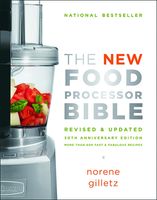Label
All
0
Clear all filters
🍜 Check out our Noodle bookshelf, and save 25% on ckbk Premium Membership 🍜
Fish and Dairy Dishes
Appears in
Published 2011
- Calculate 1 lb (500 g) per serving when buying a whole fish. One pound of fillets serves 2 to 3.
- Cook fish within 24 hours of purchase for maximum flavor. Store in the coldest part of your refrigerator.
- Fish can be stored for about 1 month in the freezer section of your refrigerator, or up to 3 months in a deep freezer.
- Thaw fish in the refrigerator, not at room temperature. Calculate 6 hours per pound in the refrigerator. In the microwave, allow 4 to 6 minutes per pound on Defrost; a few ice crystals should remain. Place in cold water for a few minutes, until ice melts. Cook and serve within a day.
- COOKING TIMES: For fresh fish, allow 10 minutes per inch of thickness at 450°F; for frozen fish, allow 20 minutes per inch of thickness. Measure fish at the thickest point. If baked in sauce, increase cooking time by about 5 minutes per inch of thickness. Cook fish just until it flakes. When done, fish should be opaque and juices on surface will be white.
- Microwave fish (e.g., salmon, halibut) between wet lettuce leaves to stop it from popping during cooking. Calculate 4 minutes per pound on High as your microwave cooking time.
- Baking, steaming, poaching, broiling, grilling and microwaving are excellent low-fat cooking methods for fish.
- Thin fish fillets don’t need to be turned when broiled. Cook about 3 inches from heat on 1 side only, just until cooked.
- Infants, young children, the elderly and those with weakened immune systems should avoid raw or undercooked eggs. Pasteurized liquid egg product can be substituted—¼ cup equals 1 egg. For more information on egg safety, proper storage, etc., check out www.aeb.org or www.fightbac.org.
- After boiling hard-cooked eggs, drain the hot water and place them under cold running water to stop the cooking process. Drain again, then vigorously shake the pot back and forth to crack the shells. Cover eggs with cold water and let stand for 2 or 3 minutes. Shells will slip off easily! If desired, discard some of the yolks.
- In the Jewish kitchen, cheese and dairy dishes such as blintzes and noodle kugels (puddings) are considered main dishes and not desserts! Team them up with a big bowl of soup and fruit or vegetable salad.
- Dishes that contain dairy ingredients (e.g., cottage or cream cheese, sour cream, yogurt, butter, milk) are traditionally served in Jewish homes as part of a dairy meal. Although they can be served as either side or main dishes, they are in this chapter because of their dairy content (e.g., Cookie’s Hot Milk Cheese Kugel). For side dishes that can be served with either meat or dairy meals, see the Vegetables and Side Dishes chapter.
- See “Cheese” in the Smart Chart for tips on processing.
- Be sure that cheeses are well chilled before shredding or slicing. Freeze softer cheeses such as mozzarella for at least 15 to 20 minutes before processing. Apply very little pressure on the pusher. Process more than you need and store in resealable bags in the freezer.
- Harder cheeses can be grated on the Steel Blade when appearance is not important (e.g., when adding them to soups and sauces).
- FLAVORED CHEESE SPREADS: Mince any of the following, using the Steel Blade: green onions, carrots, sun-dried tomatoes, roasted peppers, spinach. Add your favorite herbs (e.g., dill, basil), plus cream cheese or cottage cheese. Process until combined.
- NESTED WORK BOWLS: Choose the appropriate bowl and blade or disc for the task. Use the medium or large bowl and appropriate disc to slice or shred/grate veggies, cheese, etc. Use the large bowl and Steel Blade to chop/mince veggies or grind fish and to combine ingredients. (You can also use the Steel Blade in the medium bowl on Cuisinart Elite models.)
Become a Premium Member to access this page
Unlimited, ad-free access to hundreds of the world’s best cookbooks
Over 150,000 recipes with thousands more added every month
Recommended by leading chefs and food writers
Powerful search filters to match your tastes
Create collections and add reviews or private notes to any recipe
Swipe to browse each cookbook from cover-to-cover
Manage your subscription via the My Membership page
Best value
In this section
Advertisement
Advertisement
The licensor does not allow printing of this title


